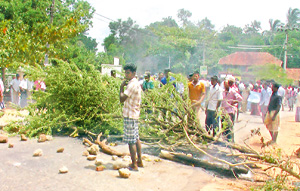15 National Parks closed for three days - Elephant census to cost Rs. 20 mn
By Pabodha Hettige
The Department of Wildlife Conservation is conducting sessions to train its officials on how to conduct the countrywide elephant census, scheduled to take place next month, sources from the Wildlife Department said. "Mock training sessions have been conducted in all parts of the country and are now being carried out in the Northern Province with the assistance of the armed forces," the DWC said.
The DWC is planning to obtain the assistance of nearly 4,000 people to carry out the census. They will include wildlife officials, university students, NGO personnel, members of the armed forces and the residents of the respective areas. The officials have been trained to avoid double counting of the jumbos and to avoid jumbo attacks. The officials will be deployed at 1,553 counting points in all the national parks, the DWC said.
Fifteen National Parks countrywide will be closed for three days in this regard from August 11 to 13, the DWC said. Accordingly Kumana, Wilpattu, Yala, Bundala, Gal Oya, Maduru Oya, Lahugala, Udawalawe, Wasgamuwa, Somawathi, Lunugamwehera, Minneriya, Angammadilla and Kaudulla National Parks and several other places will be closed for visitors due to the census.
"It is estimated that the census would cost nearly 20 million rupees," the DWC said. The census would categorize elephants into males, females, baby jumbos, wounded elephants, tuskers and record their respective numbers. A special study would be carried out regarding tuskers and the size of their tusks.
The census is based near water ways and the DWC has chosen the dry season to conduct it since the elephants come to drink water at least once a day. The DWC believes that there could be nearly 6,000 elephants’ island wide.
Previously few censuses on elephants had been carried out but this is the first countrywide census. In 1993 a census was carried out in the country except the Northern and Eastern Provinces and a total of 1,967 elephants were recorded. In 2004 nearly 1,400 elephants had been recorded in the North Western wildlife region, covering Anuradhapura, Polonnaruwa, Puttalam and Vavuniya districts. The last census was carried out in the Mahaweli wildlife region in 2008, where 2149 elephants were recorded, the DWC said.
දිවයිනම ආවරණය වන පරිදි අලි ඇතුන් සංගණනයක්
කන්තලේ - ඩබ්. ඇම්. වික්රමසිංහ
ප්රථම වතාවට මුළු දිවයිනම ආවරණය වන පරිදි වන අලි සංගණනයක් කිරීමට වනජීවී සංරක්ෂණ දෙපාර්තමේන්තුව කටයුතු යොදා ඇතැයි කන්තලේ අලි පාලන ඒකකයේ වනජීවී අඩවි සහකාර ඡේ. ඒ. පී. විජය කුමාර මහතා පැවසීය.
විශේෂයෙන්ම පසුගිය 30 වසර පුරා උතුරු නැගෙනහිර ප්රදේශවල පැවැති යුද ගැටුම් හේතුවෙන් එම ප්රදේශවල සිටින වල් අලින්ගේ නිශ්චිත ගණනයක් කිරීමට නොහැකිවූ අතර මෙම සංගණනයේ දී ඊට වැඩි අවස්ථාවක් ලබාදීමටද කටයුතු යොදා ඇත.
ජාතික වනෝද්යානවලට අමතරව දිවයිනේ සියලුම අභයභූමි හා රක්ෂිත භූමිද විශාල වශයෙන් අලි ගැවසෙන ස්ථානයන්ද ආවරණය වන පරිදි මෙම සංගණනය සිදු කෙරේ.
මේ වන විට වනජීවී දෙපාර්තමේන්තුව විසින් වල් අලින් විශාල වශයෙන් ගැවසෙන ස්ථාන 1500 කට වැඩි ප්රමාණයක් හඳුනාගෙන ඇති අතර මෙම සංගණනයේ දී දළ ඇතුන්, පැටවුන් හා රෝගී ඇතුන් පිළිබඳවද කරුණු සොයා බැලීමට තීරණය කොට ඇත.
මෙම සමීක්ෂණය සඳහා දැනට වනජීවී දෙපාර්තමේන්තුවේ සිටින නිලධාරීන්ට අමතරව රාජ්ය නොවන සංවිධානවල හා සිවිල් වැසියන්ගේ සහයද ලබාගැනීමට නියමිතය.
විශේෂයෙන් වන අලි ගැවසෙන ජලය ආශ්රිත ස්ථාන, වැව්, ඇළවල්, ගංගා, පොකුණු යන ස්ථානවල වනජීවී නිලධාරීන් සමග සිවිල් පුද්ගලයන් දෙදෙනකු යොදවා එක දිගට දින 2 ක් රැඳී සිටිමින් එම ස්ථාන වෙත එන අලින් සියල්ල නිරීක්ෂණය කෙරෙනු ඇත.
මේ වන විට වනජීවී නිලධාරීන් අලින් ගැවසෙන ස්ථානයන් පිළිබඳව පෙර විමසුම්වල යෙදී සිටින බවද විජය කුමාර මහතා වැඩිදුරටත් සඳහන් කළේය.


 Ensuring consumer welfare
Ensuring consumer welfare

